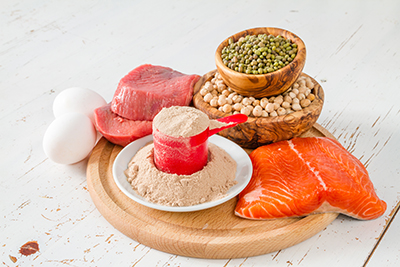How Many Grams of Sugar Is Allowed on Protein Diet

Judging by all the protein bars, shakes and powders out there, you get the impression you need more protein. There are claims it curbs appetite, helps with weight loss and builds muscle. But what's the real story?
Contrary to all the hype that everyone needs more protein, most Americans get twice as much as they need. This is especially true for males 14-70 years of age, who the 2015 Dietary Guidelines for Americans advise to decrease meat, poultry and egg consumption. Even athletes are often getting more protein than they need, without supplements, because their calorie requirements are higher, and with more food, comes more protein.
True or False: Big steak = bigger muscles
False. Although adequate protein throughout the day is necessary, extra strength training is what leads to muscle growth, not extra protein intake. You can't build muscle without the exercise to go with it.
The body can't store protein, so once needs are met, any extra is used for energy or stored as fat. Excess calories from any source will be stored as fat in the body.
Extra protein intake can also lead to elevated blood lipids and heart disease, because many high-protein foods you eat are high in total fat and saturated fat. Extra protein intake, which can be taxing on the kidneys, poses an additional risk to individuals pre-disposed to kidney disease.
How much protein do I need?
Anywhere from 10 to 35 percent of your calories should come from protein. So, if your needs are 2,000 calories, that's 200-700 calories from protein (50-175 grams). The recommended dietary allowance to prevent deficiency for an average sedentary adult is 0.8 g per kg of body weight. For example, a person who weighs 75 kg (165 pounds) should consume 60 g of protein a day.
Once you hit 40-50 years old, sarcopenia starts to set in — you start losing muscle mass as you age. To help prevent this and to maintain independence and quality of life, your protein needs increase to about 1g/kg or 75 g/day for a 75 kg person.
People who exercise regularly also have higher needs, about 1.1-1.5 g/kg. People who lift weights regularly or are training for a running or cycling event need 1.2-1.7 g/kg.
Excessive protein intake would be more than 2 g per kg of body weight each day.
If you are overweight, your weight is adjusted before calculating your protein needs in order to avoid overestimating. You can see a dietitian to help develop a personalized plan.
Where does protein come from?
The healthiest protein options are plant sources, such as soy, nuts, seeds, beans and lentils or lean meats, such as skinless, white-meat chicken or turkey, a variety of fish, egg whites, low-fat dairy and lean cuts of beef or pork.
Meet your dietary protein needs with these whole foods as opposed to supplements. Supplements are no more effective than food as long as energy intake is adequate for building lean mass. Manufactured foods don't contain everything you need from food, nor do manufacturers know everything that should be in food. There may be compounds in real foods that we haven't even discovered yet that may be beneficial for the body. So, always be careful of foods created in a lab.
When is the best time to consume protein?
Spread out protein consumption evenly throughout the day. On average, people tend to get most of their protein during evening meals and the least at breakfast. Some newer studies show moving some protein from supper to breakfast can help with weight management by decreasing hunger and cravings throughout the day. Of course, more research is needed before these claims can be verified.
General recommendations are to consume 15-25 g of protein at meals and in the early recovery phase (anabolic window) — 45 minutes to1 hour after a workout. Studies show higher intakes (more than 40 g) are no more beneficial than the recommended 15-25 g at one time. Don't waste your money on excessive amounts.
What if I do want to use a protein supplement?
If you want to use a protein supplement, here's what to look for:
- About 200 or less calories
- 2 g or less of saturated fat
- No trans fat or partially hydrogenated oils
- 5 g of sugar or less
What does 15-25 g of protein in whole foods looks like?
Eating a banana, Greek yogurt and a hardboiled egg will get you 19 g of protein on average. A 3-ounce chicken breast with a half cup rice and half cup vegetables amounts to 25 g protein.
As you can see, it's very easy to get the recommended 15-25 g per meal or post-workout snack. Of course, if these were meals, you would want to balance them out by including all food groups: protein, grain, dairy, fruit and vegetables. Most people, even athletes, can reach their protein needs by including a serving of dairy at each meal and a piece of meat the size of a deck of cards at lunch and supper.
Protein should be an accompaniment to fruits, vegetables and whole grains — it should not be the entire meal.
Kristi Wempen is a registered dietitian nutritionist at Mayo Clinic Health System in Mankato.
For the safety of our patients, staff and visitors, Mayo Clinic has strict masking policies in place. Anyone shown without a mask was either recorded prior to COVID-19 or recorded in a non-patient care area where social distancing and other safety protocols were followed.
How Many Grams of Sugar Is Allowed on Protein Diet
Source: https://www.mayoclinichealthsystem.org/hometown-health/speaking-of-health/are-you-getting-too-much-protein
0 Response to "How Many Grams of Sugar Is Allowed on Protein Diet"
Post a Comment